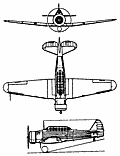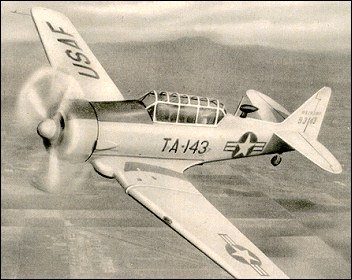|
| The first prototype NA-16 flew in April 1935. A total of about 17000 aircraft were built

| MODEL | SNJ-5 |
| CREW | 2 |
| ENGINE | 1 x Pratt-Whitney R-1340-AN-1, 410kW |
| WEIGHTS |
| Take-off weight | 2404 kg | 5300 lb |
| Empty weight | 1886 kg | 4158 lb |
| DIMENSIONS |
| Wingspan | 12.81 m | 42 ft 0 in |
| Length | 8.99 m | 30 ft 6 in |
| Height | 3.58 m | 12 ft 9 in |
| Wing area | 23.57 m2 | 253.71 sq ft |
| PERFORMANCE |
| Max. speed | 330 km/h | 205 mph |
| Ceiling | 6555 m | 21500 ft |
| Range | 1200 km | 746 miles |
 | A three-view drawing (674 x 878) |
| LT. COL. JCK STOLLY, e-mail, 26.02.2013 00:27 I WAS AN AVIATION CADET IN 1948-49 IN CLASS 49=B MUCH TO OUR SHOCK ,IN JUNE 1948, WE WERE TOLD THAT WE WERE GOING LEARN TO FLY IN THE T-6. WE WERE ABOUT THE SECOND POST WAR CLASS IN THE NEW AIR FORCE. AFTER 8 MONTHS IN THE T=6 WE WENT ON TO ADVANCED FLYING THE F-51 MUSTANG, F-80 AND THE B-25, ALL AS CADETS. 49-B GOT THEIR WINGS AND COMMISSIONS ON 1 JULY, 1949. reply | | Bill Smith, e-mail, 10.01.2013 22:13 This wonderful aircraft will always have a spot in my heart for being so forgivable! I cut my infant flying teeth on this wonderful bird. I'll never forget the acrobatics, the crosswind landings, and the open cockpit with the air flowing around the cockpit. My very first carrier landing was with this machine. I have no idea how we did it, but this one gave me my initiation into carrier flight ops. You've not lived until you've had a deck run with this bird. Great memories! reply | | Chuck, e-mail, 10.11.2012 20:53 My Father trained in an "SNJ" at Corpus Christy TX. In 1943. Later he would become an Aircraft Carrier Pilot and Ace, with the F6F-3. reply | | Leo Simons, e-mail, 26.08.2012 02:31 Primary Training at Bartow Air Base.USAF pilot training Class 54F. Instructor Howard S.Goodman. My instructor flew bombers in Europe during the was. He was simply the best and got me to graduate with flying grades above average on the T6G-Harvard. The best training aircraft ever. I think. Even instrument flying on the T6 - needle,ball and airspeed was fun. Aerobatics not easy but great, What an airplane. reply | |
| | Zippo, 25.08.2012 03:14 The T-6 it was an a famous aircraft. Least, a three quarters of all pilots of most air forces have a flow. In the advanced countries it was used like primary trainer, or adavanced trainer, in the Third World countries was used like advanced trainer or low-cost fighter. It entered servie in 1935 but in 1990 still in flight with other air forces. In the words of varios pilots, they are tell that the aircraft itīs manoureable, easy to flew and donīt need a costfull manteinance. reply | | Tamara Majkrzak, e-mail, 15.08.2012 07:45 Not sure what aircraft my dad was qualified on but he completed carrier qualifaication 9 /18 /1953 on Barin Field, Folry, Alabama. Just wanted to submit to see if anyone knew him. Frank Reese Pound Jr. from Cocoa, Fla. He passed away March 26, 2012...found old photo of this event. reply | | Frank Smith, e-mail, 27.07.2012 03:24 Class 55H at Spence AB, Moultre, Ga. Flew PA-18 and T-6. Instructor was David Spears. Once you were trained to land a T-6, you could handle any airplane on landing. Great thing about Spence was the president of Hawthorn School Aviation, Beverly "Bevo" Howard who put on an air show for every graduating class. If you are not familiar with Him. look him up...you'll be impressed. reply | | Joe West, e-mail, 26.06.2012 00:40 Blieve it or not!100 combat missions in the T-6 IN Korea.as airborneForward airController{Mosquito.} with 32 smoke rockets and lots of radio gear.DFC, Air Medal,2 oak leaf clusters. reply | | Jack Sullivan, e-mail, 17.06.2012 19:31 Brings back fond memeories of yesterday. I was an instucto at Barin Field in 1945 and 1946 and flew over 1,000 hours in the SNJ. Taught combat flying and loved it. Durin Korea I flew F2h-2 Banshees and used to pray for migs to show up so I could go to work. In Viet Nam I headed the greatest AIMD the Navy ever had and for any of you readers that attempted, or trapped in the Catapult my maintenance crew built in the O'Club a t Cubi drop me a line Sully reply | | R Thaiss, e-mail, 08.03.2012 05:20 In 1936 North American developed the BT-9 whuch had the same profile as the AT-6 excep that the landing gears were fixed. reply | | Adrienne Camfield, e-mail, 05.03.2012 02:28 Any idea what a 1946 T6 Texan Trainer looked like? I need the original art if at all possible. reply | | Frank Russell, e-mail, 12.01.2012 09:46 I trained on Harvards and instructed on them without having any mechanical failures.A really great aircaft and a joy to fly! reply | | Ralph Alshouse, e-mail, 30.11.2011 02:05 In mid 1943 the Navy was still building Whiting field near NAS Pensacola. We were flying SNJs and learning fast. We used the short runways while the Navy was extending them. Still remember a fellow cadet had engine trouble taking off, he plowed into a bull dozer and exploded, trapped in his plane with a open mic. It made all of us think much better after that. reply | | J. Yates, e-mail, 20.10.2011 22:38 My Dad (Pappy Yates)was a T-6 mechanic at Foster Field & Matagorda Island during WWII. His picture is in the AAF musuem in Victoria. reply | |
| | Rick Smith, e-mail, 21.09.2011 19:26 I flew both the T-6D and G (class 52-D).
My memory of the D model is not a good one. We had 3 deaths due to no spin recovery. It was grounded until they discovered the cause.
On the D model, in order to taxi, you had to push the stick forward to disengage the pin that held the tailwheel in place. Turns out the pin was sticking and the pilots could not push the stick forward to recover from the spin. All the pins were inspected and routinely lubricated and checked after that.
However, the T-6 was a fun aircraft. I used to get red eyes from inverted spin recoveries. I blew several hay stacks over on a low level flight and the farmer got my tail number. Fortunately, my instructor (Capt. Robert E. Lee) told the stage commander that he had assigned me a low level mission. I spent several weeks working with the farmer stacking hay as a result. Capt. Lee got a fifth of scotch. reply | | J. William Love, Jr., e-mail, 28.07.2011 10:31 I flew the T-6 in basic training Class 52-B at Greenville AFB MS. Great memories. I had a great instructor named Mr. Lucie. Fortunately, he was a very patient man. Most of our instructors were local area crop dusters, and really good pilots. Any other members of the 52-B class out there? reply | | Walt downs, e-mail, 04.07.2011 22:13 I was stationed at Barin from school in Memphis. 1953-54. Worked in no.4 hangar in air to air gunnery,welcomed flight time in Jbird to observe tow. Liberty in Foley at the American Leagon hall dances friday nights. Still remember it well Looking for bruce Bergner for 50 years. reply | | Walt downs, e-mail, 04.07.2011 22:06 I was stationed at Barin from school in Memphis. 1953-54. Worked in no.4 hangar in air to air gunnery,welcomed flight time in Jbird to observe tow. Liberty in Foley at the American Leagon hall dances friday nights. Still remember it well Looking for bruce Bergner for 50 years. reply | | Paul Huston, e-mail, 24.06.2011 03:22 My father was an "old guy" when he joined the Navy in 1942 at the age of 21. He had two years of college and a pilot's license so the Navy comissioned him and he ended up in Corpus Chisti for a while as an instructor. He told me stories of taking the cadets out over the Gulf of Mexico, getting them lost and teaching them to find their way back, of dive bombing and strafing, air to air target pratice, aerobatics and everything else required to survive the war. I think he always hoped he had done something along the way to give them the edge that would make them come back home and I know he wondered what happened to them after he sent them on. He told some serious stories, and you could tell he cared deeply about his time there, but most of the stories were light hearted or funny and tended to show that these guys formed friendships that would last forever. He loved his Navy days, stayed in the reserves and served during Korea and then left the Navy as he had found a job flying for American Airlines in 1951. He flew the N3N, N2S, and variants of them, the SNVs, SNJ,s and lots of other types as well as many multi-engine aircraft. His service in the Navy gave him valuable skills that made him a successful airline pilot and provider for his family. To all of you who have served, I owe a debt of gratitude as you have stood up for our nation at times when others didn't care.
Any of you ever strafe Padre Island, by any chance? Or have any of you trimmed it slightly nose up and tried to see how close they could get their prop tips to the wave tops? No way! Military pilots obey all the rules and regulations! Right? And about those relief tubes.....yes they would freeze up. Dad said it shocked his straight laced parents when they found out that's how you were supposed to relieve your self on long flights.
FLY NAVY! reply | | William McMorrow, e-mail, 27.05.2011 16:14 Would someone know of any books written about Hondo Airfield, circa early fifties? My father, a Colonel,USAF (Ret.) trained there and claims he saw such a book but can now not recall where it was he saw it.
Any help in this matter would be most appreciated! Thank you. reply |
|
Do you have any comments?
|
| 
COMPANY
PROFILE
All the World's Rotorcraft
|













